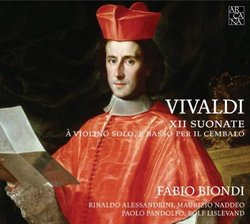A lucky accident
Jon Chambers | Birmingham, England | 04/21/2010
(5 out of 5 stars)
"Although written nearly 300 years ago, Vivaldi's 'Manchester Sonatas' were only recently rediscovered - by the very same Michael Talbot, as it happens, who supplies the liner notes to this Arcana recording. In these notes, he says modestly, 'the writer of these lines stumbled on the sonatas by accident, in 1973, while looking for something quite different.' Elsewhere, however, he is more expansive. 'It was soon evident,' he says in Proceedings of the Royal Musical Association, 'that the sonatas constituted an important discovery: six were unique to the Manchester manuscript (discounting individual movements found elsewhere), and two others were known only from incomplete sources...' It would be very much easier today, with computer searches and plentiful recordings, to realise that a piece of Vivaldi is not known elsewhere. It took someone with Talbot's encyclopaedic knowledge, however, to make this discovery back then. He is not considered the world's foremost authority on Vivaldi without good reason.
But what of the musical quality of these sonatas? And what of the quality of the performance by Fabio Biondi et al? Although there is nothing revolutionary about them (they are all examples of the four movement form combining two dance movements with two slower ones), the sonatas are melodic and inventive enough to warrant frequent listenings. Certainly, their charms grow with each new hearing.
As for Biondi's playing, its colour and charisma sustain the listener's interest in works which do, after all, contain a high proportion of repeated material. This is partly because he allows himself plenty of artistic licence. In fact, it was a Baroque requirement that soloists provide their own decorative embellishments of simple, melodic lines. But part of Biondi's variation stems from the fact that his natural style depends on contrast. The very opening bars of Sonata No 1 in C illustrate this well. His entry is dulcet-smooth, but is abruptly followed by staccato double-stopping. In fact, the whole 2CD recording is packed with contrast, to prevent listener fatigue no doubt. The original running order is changed so that major tonalities alternate with minor ones. The harpsichord continuo alternates with chamber organ, and theorbo with baroque guitar.
It is the accompaniment that provides the real talking point as well as much of the contrast. The title page specifies a harpsichord to accompany the solo violin. Talbot makes the point that 'cembalo' could be interpreted in a wider, generic sense, but there's no doubt that originally these sonatas would have been played by violin and harpsichord alone - even in so lavish and musical household as Cardinal Ottoboni's (for whom the manuscript collection was made, and where Corelli spent the later years of his life). There's no doubt, too, that the five instrumentalists of this recording, as opposed to the two originally conceived by Vivaldi or the three of Andrew Manze's recording on the Romanesca label, create a thick musical texture often more akin to the chamber concerto than the sonata. With cello and double-bass reinforcing plucked strings and keyboard, the continuo part can also sound bass heavy. Whether or not this sound is to your taste is probably of greater importance than whether it is authentic or not. It isn't. But most of us seem to appreciate a greater injection of bass sound these days. A fine recording, therefore, and a worthy challenger to Andrew Manze even if, like his, it is one that is getting on. (Biondi's dates from 1991, Manze's from 1993.)
"


 Track Listings (24) - Disc #1
Track Listings (24) - Disc #1